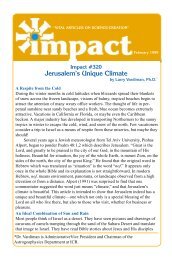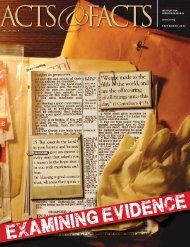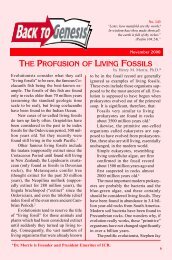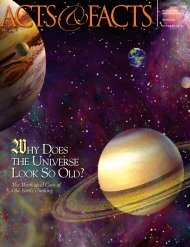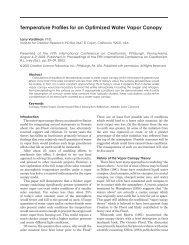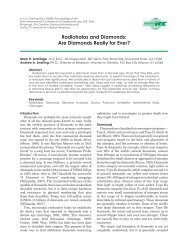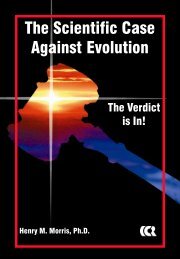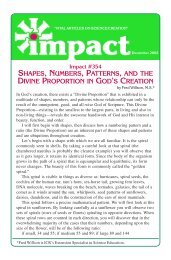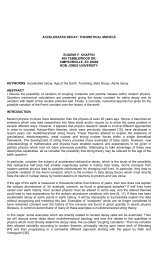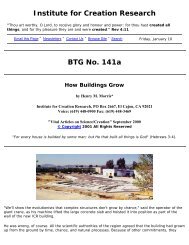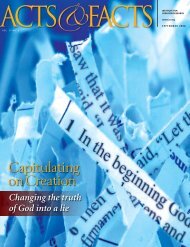U-Th-Pb MINERAL DATING IN DOUBT - Institute for Creation ...
U-Th-Pb MINERAL DATING IN DOUBT - Institute for Creation ...
U-Th-Pb MINERAL DATING IN DOUBT - Institute for Creation ...
Create successful ePaper yourself
Turn your PDF publications into a flip-book with our unique Google optimized e-Paper software.
tion” consistent with a constant loss of U decay products. Wetherill 4 and Wasserburg 5subsequently derived mathematical equations to describe this steady loss anddemonstrated its consistency with published U-<strong>Pb</strong> age data.Wasserburg 5 also proposed that <strong>Pb</strong> loss by diffusion resulted from radiationdamage to crystal lattices. In fact, it has now been confirmed that radiation damagecan drastically increase the rate of <strong>Pb</strong> diffusion. 6 While the diffusion rate is “knownto be slow” and difficult to determine accurately, 7 higher temperatures induce fasterdiffusion. <strong>Th</strong>is is dramatically illustrated by the contact metamorphic effects of aTertiary granite stock on zircon crystals in surrounding regionally metamorphosedPrecambrian sediments and volcanics. 8 Within 50 feet of the contact, the 206 <strong>Pb</strong>concentration drops from 150 ppm to 32 ppm, with a corresponding drop in 238 U“ages” from 1405 Ma to 220 Ma.Zircon crystals are often chemically and physically inhomogeneous, 7 reflectinggrowth during crystallization from magma. Both zoned and unzoned zircon crystalsmay be found in the same rock. Pidgeon 9 demonstrated that unzoned crystals can bethe result of recrystallization of zoned crystals accompanied by loss of U, <strong>Th</strong>, and <strong>Pb</strong>,and “resetting” of the U-<strong>Pb</strong> “ages.” Such recrystallization can be due to subsequentregional metamorphism. Kröner et al. 10 found that high-grade metamorphism ofgranitic and related rocks reduced their U-<strong>Pb</strong> zircon “ages” from 1000 Ma down to540 Ma, with zircons even from a single sample yielding U-<strong>Pb</strong> “ages” between 1072Ma and 539 Ma. <strong>Pb</strong>-loss was severe and from entire grains.Yet another significant problem <strong>for</strong> zircon U-<strong>Pb</strong> “dating” is the discovery insome metamorphic and granitic rocks of zircon crystals that yield much older “ages”than the accepted ages of the rocks. In the case of metamorphic rocks this has beeninterpreted as inheritance of those zircon grains from the original sources of thesediments, the zircons somehow surviving metamorphism without resetting of the U-<strong>Pb</strong> isotopic system. 10,11 <strong>Th</strong>ese “older” zircons in granitic rocks are likewise interpretedas being inherited from the source rocks that melted to produce the magmas. 12,13<strong>Th</strong>ese situations are enigmatic, given the dramatic effect of similar temperaturesduring contact metamorphism. In some published studies, the inherited zircons are 5–10 times “older” than those matching the accepted ages of granites—1753 Ma in a 21Ma Himalayan granite 14 ; 3,500 Ma in a 426 Ma southeast Australian granodiorite 15 ;and 1638 Ma in a 370 Ma New Zealand granite. 16However, if <strong>Pb</strong> is lost from some mineral grains, then it is to be expected it willbe inherited in other crystals. <strong>Th</strong>us Williams et al. 17 found unsupported (or excess)radiogenic <strong>Pb</strong> in a zircon crystal in an Antarctic gneiss, identified as such because theradiogenic <strong>Pb</strong> thus produced anomalously high “ages.” Similar situations also resultin “ages” hundreds of millions of years more than expected and are interpreted as dueto excess radiogenic <strong>Pb</strong>, the origin of which is either explained as mixing from oldersource materials and/or due to migration as a result of fluids, temperature, andpressure. 18,19 <strong>Th</strong>is all begs the question—should “anomalously old” zircons beinterpreted as inheritance of the zircon crystals, or of the “excess” radiogenic <strong>Pb</strong> inthe crystals? And if even weathering produces large <strong>Pb</strong> losses, 20 then how reliable areany U-<strong>Pb</strong> zircon “ages”?Finally, radiogenic <strong>Pb</strong> has been found to vary within most tested zircon grains ona 20 micron spatial scale. 21 Some spots were characterized by very large concentrationsof radiogenic <strong>Pb</strong>, up to 30 times the “expected” values. Furthermore, pro-ii



